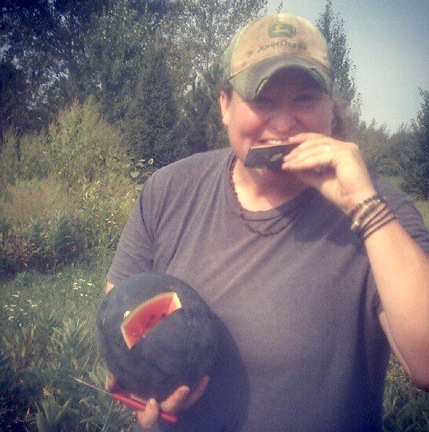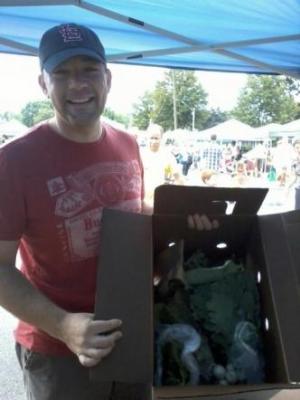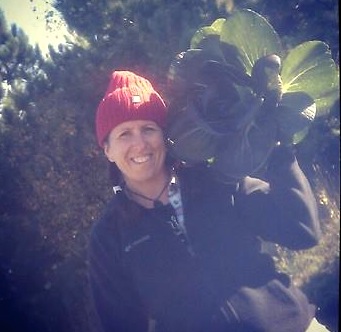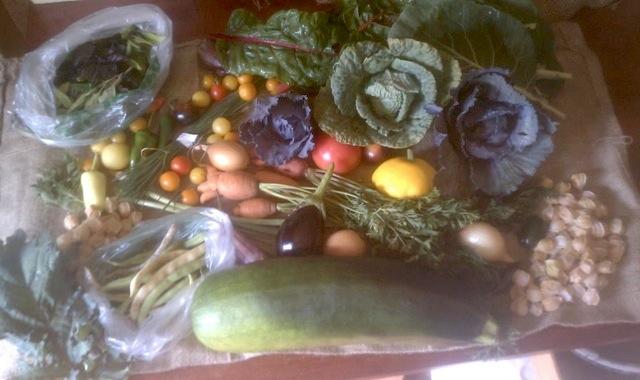This is the first post in a new SGT series that looks at CSA – community supported agriculture – from the farmer’s perspective.
People come to farming from different directions. Some grow up on farms, lugging around seed bags and feed buckets just after their first steps, while others are drawn to the profession later in life, as if it's an avocation they can no longer resist. My partner, Karla Pankow, and I are definitely of the latter group. In 2011, we started our own farming venture, Bossy Acres, and kicked off our first full season last year.
 Bossy Karla does quality assurance testing on some melonAlthough Karla had done some farm internships in the past
and soaked up farm knowledge like a polyglot learning a new language, she had
to ditch the corporate world at age 33
for a chance to play in the dirt. As for me, I've been a freelance writer for two
decades, but always felt like something was missing, like I was one step
removed from doing compelling, passionate work because my job was to interview
those people instead of living that life myself.
Bossy Karla does quality assurance testing on some melonAlthough Karla had done some farm internships in the past
and soaked up farm knowledge like a polyglot learning a new language, she had
to ditch the corporate world at age 33
for a chance to play in the dirt. As for me, I've been a freelance writer for two
decades, but always felt like something was missing, like I was one step
removed from doing compelling, passionate work because my job was to interview
those people instead of living that life myself.
When we decided to start a farm together, we knew immediately that we wanted to focus on community supported agriculture (CSA) as our fundamental model. We love the freshness that comes with local, just-picked vegetables and knew that so many other people feel the same way. More than that, though, a CSA is a connection between farmer and customer that's closer than even a farmers market relationship. In going back to the land, we thought: how awesome would it be if we could know who was eating what we grew, and they, in turn, could connect with the people who planned, planted, weeded, watered, and harvested their dinner?
In this series, Behind the CSA Box, I plan to give a glimpse into that connection from the farmer's perspective, and that starts with some CSA basics.
CSA 101
At its most fundamental level, a CSA is a "share" in a farming season. You pay upfront, usually before May and ideally by early April, for a portion of a farmer's vegetables for the season ahead.
The price is set by the farm; at Bossy Acres, our CSA is $600 for a full share (delivered every week) and $350 for a mini share (delivered every other week). This is a fairly typical price, and it might give some people sticker shock to think of paying that much upfront (more on that in a minute), but because the season is around 18 to 20 weeks, from June to October, it ends up being about $34 per week for almost a bushel box of vegetables.
 CSA member Mark with his share
CSA member Mark with his share
On delivery day, you get a box of vegetables based on whatever's ready to harvest at that time. And by "ready at that time," I mean ready that very day: like most farms, we harvest for our CSA in the morning and deliver in the afternoon. That makes for a bit of a chaotic day on our end, but it means that when you use those radishes or tomatoes, you can luxuriate in the knowledge that they're only a few hours from harvest.
Boxes are delivered to dropsites, which are sometimes at people's homes but often are located at co-ops, churches, business offices, farmers markets, and other locations. Mostly, they're not supervised, so you'll just see a few columns of brown or white boxes and you can claim one of them.
You have a window of time for pickup, usually in the late afternoon to early evening. On the delivery day, you simply zip over to your dropsite, check your name off a list, pick up your box, and head home to figure out what to do with your new abundance of vegetables.
CSA memberships also come with a nice amount of interaction with the farmer. With every delivery, you'll get a newsletter about what's in the box, and also updates on the farm with photos and little stories. Most CSA farms hold member events at the farm at least once a season, where you'll get to go and see the fields, and maybe pick some vegetables yourself.
One important note is that the amount and diversity of vegetables is going to vary quite a bit throughout the season. At the start, you might get about five to seven pounds of vegetables, and it's likely to lean toward salad greens and a couple other early season favorites like radishes. By August and September, that box could be 30 pounds with 15 different types of vegetables. The season tapers off in late September and early October, when a box is comprised mainly of root crops like turnips, beets, and carrots, although there's often some hearty kale that sticks around too.
How It Works
Sometimes, I get asked, "Why do a CSA when I can just go to the farmers market or co-op and buy local vegetables there?"
Those are both great ways to support local farmers, but I love answering this question because it gives me an opportunity to talk about why CSAs aren't just a convenient arrangement for the consumer (well-priced, super-fresh produce delivery) – they can be vital for the farmer and the farm's existence.
In the spring, farmers face a huge array of costs, including seeds, new equipment, irrigation supplies (sadly, drought might be the new normal), greenhouse gear, truck repairs, and on and on. The CSA financial model allows us to get the money we need at the start of the season, rather than having to take out a loan and hope that we make enough to pay it back before October.
That means that being a member of a CSA isn't necessarily all sunshine and rainbows (and beets). If something terrible happens at the farm, like flood or tornado, and the crop gets wiped out, shareholders lose their investment. There are no refunds, because the money you handed over in the spring is largely already spent. But more importantly, your CSA support means that, in the event of disaster, the farmer won't get crushed beneath the financial weight of crop loss.
Farming can be an amazing, wondrous life that's filled with soul-quenching moments. To sit back on your heels and look at a row of kohlrabi or potatoes, knowing that those vegetables will go to local tables, creates a feeling of being nourished by more than food. At the same time, the amount of effort and expense it takes to get to that moment can be astounding. If you're not careful, it can break you, in every possible way.
With a CSA, we know that we're not alone. Our members will support us for those early season purchases, but in other ways as well. They'll cheer us on, remind us why we're doing this, hold us together when we're ready to crumble. And believe me, after a 15-hour day of weeding thistles in July heat, we need that support as much as we need water.
In future installments of Behind the Box, I'll cover all kinds of delicious farm topics like crop planning (an art as well as a math lesson), relationships with customers, different kinds of CSAs, and member-to-farmer communications. Stay tuned, and you'll get a nice helping of farm experience without the lower back sunburns and annoying woodticks. Until then, stay warm and stay bossy!

Elizabeth Millard owns Bossy Acres with her partner, Karla Pankow. They grow an array of delicious vegetables in Northfield, using sustainable and organic methods. This winter, they can be found teaching classes on indoor growing at Harvest Moon Co-op, Linden Hills Co-op, Egg/Plant Urban Farm Supply, and Mother Earth Gardens. Follow them on Facebook and on Twitter at @BossyAcres.

